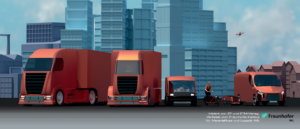Delivery drones will probably remain a niche solution, but in just a few years, driving delivery robots will be everyday features, both in major cities and rural regions. These are the findings of the 3rd ZF future study, which focuses on “Logistics on the Last Mile“. The Fraunhofer Institute of Material Flow and Logistics (IML) conducted a 360-degree study of customer expectations, statutory and spatial framework conditions as well as technical trends and their impacts.
Fraunhofer reports:
“Above all in densely populated centers, it is crucial to speed up and smarten up the “last mile“. The main customers using e-commerce today are young people in 1- or 2- person households, and this demographic is growing continuously. Customers demand ever-faster delivery, and not just for fresh produce. Same-day delivery is already standard, and the trend is toward same-hour delivery. These demands can only be met with shorter logistics paths. The way forward is to establish local distribution centers and decentralized organization to cut distances to customers. Consumers in rural areas and medium sized towns also want fast delivery. However, the much lower population density puts huge cost pressure on logistics service providers. With current technology, time-critical services – such as fresh food delivery – are not as viable in these areas.

Prof. Dr.-Ing. Uwe Clausen of the German Fraunhofer Institute explains: “Transport logistics always has to square the circle between customer requirements, new technologies and spatial as well as political framework conditions. Therefore, growing cost and innovation pressure is not only down to rising consumer expectations. Even today, delivery traffic is already increasingly restricted, regulations for driveline technology are being tightened and access to certain inner-city areas is subject to fees. Therefore, there is an urgent need for an efficient, clean logistics concept for towns and major cities. Clean, efficient logistics with digital networking In the future, intelligent algorithms will be able to anticipate orders and transport requirements. Ideally, the merchandise will already be in the direct vicinity of the customer while they are placing their order. Knowledge about consignments and their recipients helps make deliveries flexible and efficient”.
The authors of the study believe that new technologies which enable innovative forms of transport, or even make transport superfluous, will trigger the greatest changes. For instance, 3D printing will enter the mainstream. Additive processes can manufacture many goods on the spot, avoiding time-critical transports. 3D printing shops are one conceivable development, similar to the photocopying shops that thrived back in the days when not every household owned an ink-jet printer. Drones will remain an exception The study identifies a big role for autonomous driving, although delivery personnel will still be necessary. Their job will change, because the transport vehicle will automatically follow them from house to house, to give an example. In rural areas, autonomous delivery vehicles can reduce the high cost pressure on logistics companies struggling with an increasing shortage of drivers. And road-bound transport robots can also be used for the last mile in urban areas.
Germany deliveries will take place throughout Germany by 2030. Safety concerns, however, will keep transport drones restricted to niche activities. Electric motors enable overnight transport which occurs quickly and quietly for the last mile. However, at least in the near future, internal combustion engines will remain in use outside the major urban centers. The reasons for this are range and economic constraints. Logistics is for everybody. This becomes especially clear at Christmas, when up to eight million parcels are delivered to their target locations daily. This is 240% more than usual. Yet on-the-nail delivery logistics is a challenge all year round, in major cities as well as in small towns and rural areas.
Source: Fraunhofer IML.
